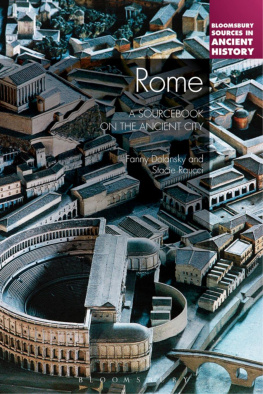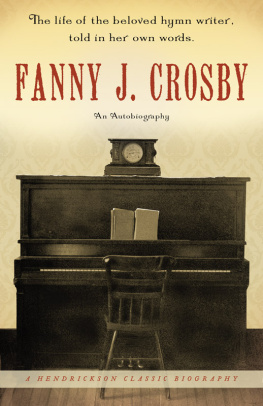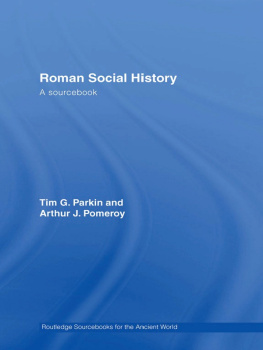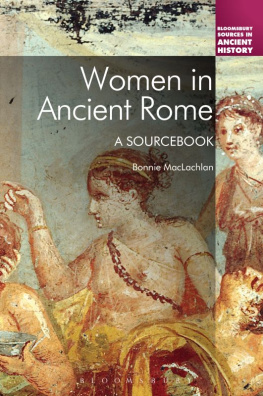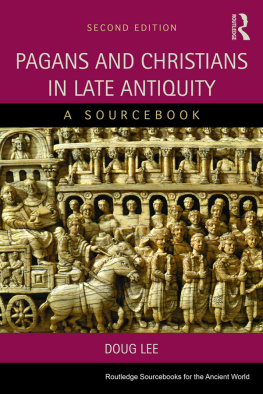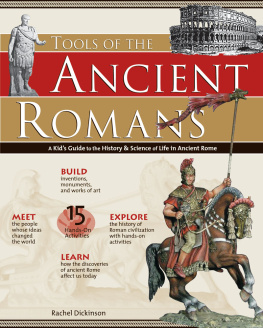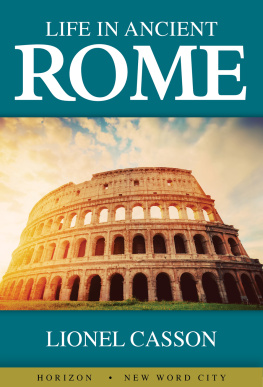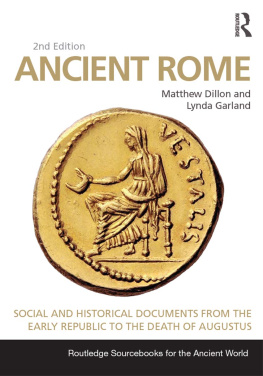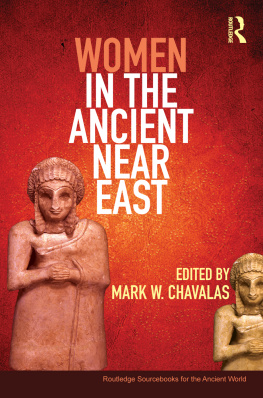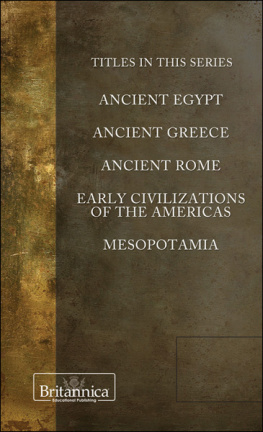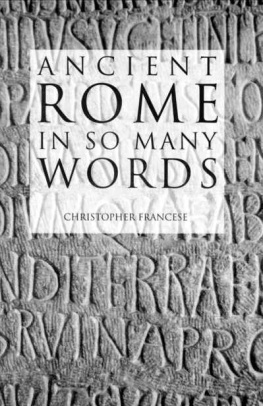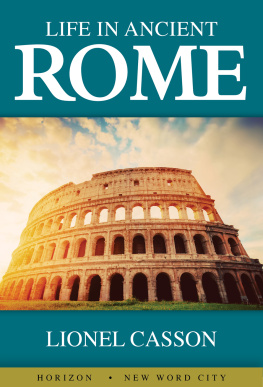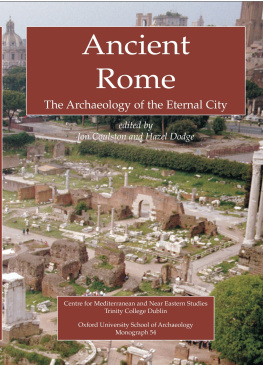Fanny Dolansky - Rome: A Sourcebook on the Ancient City
Here you can read online Fanny Dolansky - Rome: A Sourcebook on the Ancient City full text of the book (entire story) in english for free. Download pdf and epub, get meaning, cover and reviews about this ebook. year: 2019, publisher: Bloomsbury, genre: Art. Description of the work, (preface) as well as reviews are available. Best literature library LitArk.com created for fans of good reading and offers a wide selection of genres:
Romance novel
Science fiction
Adventure
Detective
Science
History
Home and family
Prose
Art
Politics
Computer
Non-fiction
Religion
Business
Children
Humor
Choose a favorite category and find really read worthwhile books. Enjoy immersion in the world of imagination, feel the emotions of the characters or learn something new for yourself, make an fascinating discovery.
- Book:Rome: A Sourcebook on the Ancient City
- Author:
- Publisher:Bloomsbury
- Genre:
- Year:2019
- Rating:4 / 5
- Favourites:Add to favourites
- Your mark:
- 80
- 1
- 2
- 3
- 4
- 5
Rome: A Sourcebook on the Ancient City: summary, description and annotation
We offer to read an annotation, description, summary or preface (depends on what the author of the book "Rome: A Sourcebook on the Ancient City" wrote himself). If you haven't found the necessary information about the book — write in the comments, we will try to find it.
Rome: A Sourcebook on the Ancient City — read online for free the complete book (whole text) full work
Below is the text of the book, divided by pages. System saving the place of the last page read, allows you to conveniently read the book "Rome: A Sourcebook on the Ancient City" online for free, without having to search again every time where you left off. Put a bookmark, and you can go to the page where you finished reading at any time.
Font size:
Interval:
Bookmark:
Rome
Bloomsbury Sources in Ancient History
The Bloomsbury Sources in Ancient History series presents a definitive collection of source material in translation, combined with expert contextual commentary and annotation to provide a comprehensive survey of each volumes subject. Material is drawn from literary, as well as epigraphic, legal, and religious sources. Aimed primarily at undergraduate students, the series will also be invaluable for researchers, and faculty devising and teaching courses.
Athenian Democracy: A Sourcebook, Luca Asmonti
Christianity in the Later Roman Empire: A Sourcebook, David M. Gwynn
Food and Drink in Antiquity: A Sourcebook, John F. Donahue
Greek and Roman Sexualities: A Sourcebook, Jennifer Larson
Rome: A Sourcebook on the Ancient City, Fanny Dolansky and Stacie Raucci
Women in Ancient Rome: A Sourcebook, Bonnie MacLachlan
Women in Ancient Greece: A Sourcebook, Bonnie MacLachlan
Rome
A Sourcebook on the Ancient City
Fanny Dolansky and Stacie Raucci
Bloomsbury Academic
An imprint of Bloomsbury Publishing Plc

Figures
Maps
This book was written with the support of many people. We would like to thank the editorial staff at Bloomsbury Academic for their guidance and patience, especially Alice Wright, Lucy Carroll, and Clara Herberg. We are indebted to the anonymous readers for the press who provided valuable feedback on the initial proposal and the manuscript as a whole. A number of institutions offered crucial funding and spaces to write: the Humanities Research Fund at Union College, the Mary Elvira Stevens Traveling Fellowship from Wellesley College, the Fondation Hardt in Switzerland, and the Humanities Research Institute at Brock University, which supported both an early period of research in Rome and reproduction rights for the images in the volume.
Special thanks to Eliza Burbano and Pierre Castro, extraordinary undergraduate research assistants at Union College, and to the students in our classes for being sounding boards for this book.
On a more personal note, Stacie would like to thank her husband Patrick Singy and her parents Joseph and Lenore Raucci for endless support. Fanny would like to thank Phil Venticinque for helpful critique and encouragement at the beginning of this project in particular, and her family, especially her parents Ben and Diane and younger sister Lila, for support throughout.
Kings (traditional dates)
Romulus | 753715 BCE |
Numa Pompilius | 715673 BCE |
Tullus Hostilius | 673642 BCE |
Ancus Marcius | 642617 BCE |
Lucius Tarquinius Priscus (Tarquin the Elder) | 616579 BCE |
Servius Tullius | 578535 BCE |
Lucius Tarquinius Superbus (Tarquin the Proud) | 534510 BCE |
Emperors
Augustus | 27 BCE14 CE |
Tiberius | 1437 CE |
Caligula | 3741 CE |
Claudius | 4154 CE |
Nero | 5468 CE |
Galba | 6869 CE |
Otho | 69 CE |
Vitellius | 69 CE |
Vespasian | 6979 CE |
Titus | 7981 CE |
Domitian | 8196 CE |
Nerva | 9698 CE |
Trajan | 98117 CE |
Hadrian | 117138 CE |
Antoninus Pius | 138161 CE |
Marcus Aurelius | 161180 CE |
Lucius Verus | 161169 CE |
Commodus | 177192 CE |
Pertinax | 193 CE |
Didius Julianus | 193 CE |
Septimius Severus | 193211 CE |
Caracalla | 211217 CE |
Macrinus | 217218 CE |
Elagabalus | 218222 CE |
Severus Alexander | 222235 CE |
Maximinus | 235238 CE |
Gordian I and II | 238 CE |
Balbinus and Pupienus | 238 CE |
Gordian III | 238244 CE |
Philip | 244249 CE |
Decius | 249251 CE |
Gallus | 251253 CE |
Valerian | 253260 CE |
Gallienus | 253268 CE |
Claudius Gothicus | 268270 CE |
Aurelian | 270275 CE |
Tacitus | 275276 CE |
Probus | 276282 CE |
Carus, Carinus, Numerian | 282285 CE |
Diocletian | 284305 CE |
Maximian | 286305 CE |
Constantius | 305306 CE |
Galerius | 305311 CE |
Maxentius | 306312 CE |
Constantine | 306337 CE |
Licinius | 313323 CE |
The purpose of this volume is to lead you, the reader, on a journey through the ancient city of Rome via selected writings from antiquity. Inside these pages you will find passages from ancient Greek and Latin texts that we have translated into English and provided commentary on, where appropriate. This sourcebook is meant to provide you with an experience that is at the intersection of topography, social history, and cultural studies. This is why we have chosen to organize our book by themes rather than by geographical regions of the city. As you will see, there are chapters devoted to politics, spectacles, religion, and daily life, among other topics. Our overarching goal has been to place the sites of the city in the context of the lived experience of its inhabitants. In order to understand and appreciate the perspectives of the inhabitants as much as possible, we have provided chapters that explore the city at both ordinary and extraordinary moments of life.
Why take this thematic approach? We wanted to bring awareness to the symbiotic relationship between the city and its people. Diane Favro (1999: 205) aptly notes that, Roman urban settings were not mere backdrops, but active participants in city life. She adds (206) that urban sites could function as director, actor, and audience. While in this last phrase at least Favro is discussing the role of the city in Roman performances specifically, the idea can be applied to the city as a whole and is a useful framework to help us think about the living city. The spaces of the city could facilitate certain kinds of activities and serve as witness to events. In turn, people could change the way urban sites were used through their actions. By mingling monuments with experiences, we hope that you will begin to see a vibrant relationship between the city and its inhabitants and thereby picture the living city.
Walking through the streets of Rome long after the time periods covered in this volume, many people have commented on the ruins we still see standing today, whether they are the easily spotted and magnificent remains of the Colosseum Romes many layers of history are visible in its remains. This is why, as you engage with Romes cityscape and the texts contained within this volume, you should try to remember that the marks left by people on the city have been made over many periods of time. Author Andr Aciman (2002: 3) writes that, Rome is not about one path, or about one past, but an accumulation of pasts. In reading the literary, historical, and inscriptional sources in this volume, one should keep in mind that ancient writers were not all looking at the same Rome. They were writing in different time periods and therefore looking at different cityscapes from each other. And of course they were bringing different perspectives, too, based on their individual backgrounds and particular circumstances.
Next pageFont size:
Interval:
Bookmark:
Similar books «Rome: A Sourcebook on the Ancient City»
Look at similar books to Rome: A Sourcebook on the Ancient City. We have selected literature similar in name and meaning in the hope of providing readers with more options to find new, interesting, not yet read works.
Discussion, reviews of the book Rome: A Sourcebook on the Ancient City and just readers' own opinions. Leave your comments, write what you think about the work, its meaning or the main characters. Specify what exactly you liked and what you didn't like, and why you think so.

